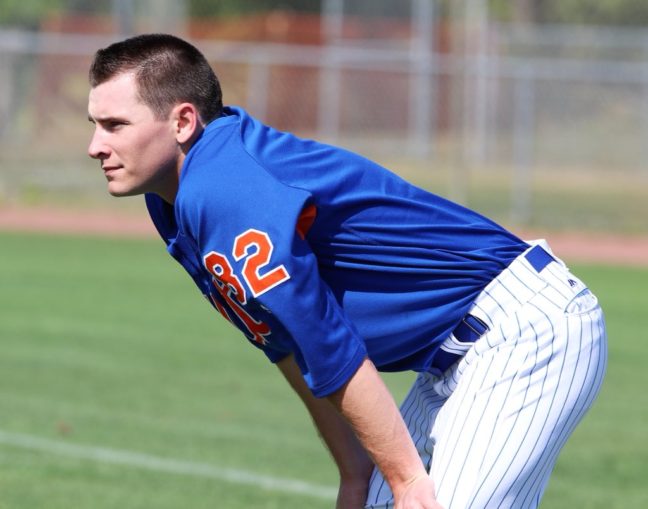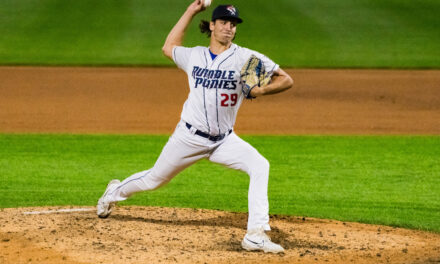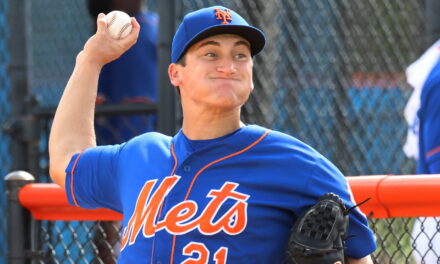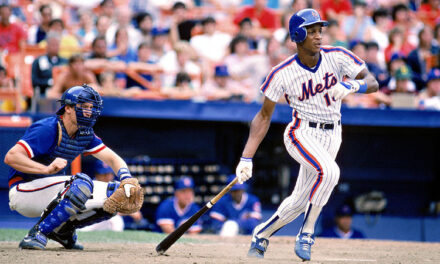
During spring training, we interviewed pitching prospect Drew Smith who was just called up by the Mets and will be making his major league debut. Here’s that interview as conducted by MMO Senior Writer Mathew Brownstein. Enjoy.
When the New York Mets decided to become sellers last season, unloading many of their upcoming free agents in hopes of adding young, controllable talent, fans were hopeful that at least a few of the new names could make an impact as soon as 2018.
While the club has already promoted and given opportunities to several of their acquired prospects (Jamie Callahan, Jacob Rhame and Gerson Bautista), a new name is added to that list starting Friday night.
Meet Drew Smith.
Smith, 24, was acquired in the deal that sent first baseman Lucas Duda to the Tampa Bay Rays in late July. The right-handed reliever was selected in the third round of the 2015 MLB June Amateur Draft out of Dallas Baptist University in Dallas, Texas.
After spending just two seasons with the Tigers minor league affiliates, Smith was traded to the Rays at the end of April in 2017 as the PTBNL to complete an earlier trade that involved outfielder Mikie Mahtook.
The 2017 season was a busy one for the six-foot-two reliever, as he pitched for three organizations and five different teams.
While the constant movement and changing of teams would make most adjustment periods tough, Smith embraced the challenge. He noted that the season went by that much quicker with relocating and learning who is new teammates were. The adjustment periods were always there, yet Smith continued to do what he knows best, produce on the mound.
In 42 games, Smith posted a combined ERA of 1.65, with 57 strikeouts to just 14 walks in 60.0 innings pitched. Featuring a fastball that sits in the low to mid-nineties, a curve (which he notes some call a slider), and a changeup, Smith has continued to impress so far in 2018.
After making just two appearances with Double-A Binghamton to start the year, Smith was promoted to Triple-A Las Vegas in mid-April. Over 23 combined games, Smith has posted a 2.88 ERA, with a 1.136 WHIP, and 8.9 SO/9. Even in the hitter-friendly confines of the Pacific Coast League, Smith has continued to limit the long ball, giving up just three in 30 innings pitched with the 51s.
His splits have been impressive as well, as he’s held right-handed hitters to a .677 OPS over 78 plate appearances, and has been even stronger against lefties, holding them to a .650 OPS with 17 strikeouts to just three walks in 62 plate appearances.
After the Mets optioned right-handers Chris Flexen and Paul Sewald to Triple-A after Thursday’s 6-4 loss to the Colorado Rockies, Anthony DiComo reported that Smith and outfielder Kevin Kaczmarski were getting called up to meet the club in New York as they get set to face the Los Angeles Dodgers for three at home.
Smith’s performance this year certainly warranted a promotion to Queens. With the Mets’ bullpen struggles of late, Smith looks to infuse some life into it and help spark a mid-season turnaround for the club.
I had the chance to interview Smith in early March of this year, where we discussed his introduction to pitching, playing for three different organizations (and five teams) in 2017 and his early connection to Noah Syndergaard.
MMO: Growing up who were some of your baseball idols?
Smith: I was a big Texas Rangers fan. Being from Fort Worth I always liked Michael Young.
When I was younger I actually didn’t start pitching consistently until I was about fourteen, so I was more of a position player. All of my favorite players were position players, which is pretty weird.
I liked Young and Hank Blalock; I was big into the Rangers back then. I even liked A-Rod for a short time when he was with the Rangers until he went to the Yankees and had the whole steroid debacle.
MMO: You mentioned that you were primarily a position player until your early high school years, how did you get introduced to pitching?
Smith: I pitched when I was young – nine-ten-eleven – but I really didn’t pitch a lot and I was more of a shortstop and center fielder.
Then freshman year of high school, when I was fourteen, I threw in maybe two games. It wasn’t until my sophomore year of high school that I started pitching consistently.
I started on JV and went up to varsity and after that things just started clicking on the mound, so I went to college as a full-time pitcher.
MMO: I noticed while looking at your college stats that you experienced much better success in your junior season compared to your sophomore year. You went from a 5.79 ERA to 3.97 and lowered your walks-per-nine from 6.43 to 3.38. What were some of the adjustments you made to see the success that you had?
Smith: A lot of it had to do with just getting to know my body better. Going to Dallas Baptist I was throwing consistently anywhere from 87-90 mph. That sophomore year is when I made my first big velo jump; I was anywhere from 92-96 and touching 97.
I didn’t really know how to control that so my walk total went up. I was also injured a little bit that year. I think due to the quick increase in velocity my body had trouble adjusting.
Junior year I gained a little more velo but it wasn’t as big of a jump, I’d been pitching with that velo for over a year. I think it just helped me get into a better routine and know my body better.
The second half of the year is when my control and command took a big turn. I think a majority of my walks happened in the first half, so I ended the year really strong. [My] numbers weren’t as good as I’d hoped but obviously, it was good enough to get noticed and that was just the biggest thing for me, getting to know my body better.

Photo By Logan Barer (@LBarer32)
MMO: What do you attribute the boost in velocity towards?
Smith: We do a lot of stuff at Dallas Baptist. We did the weighted ball thing; it’s controversial as some people like it and some don’t. I loved it.
It wasn’t as intense as some of the programs out there now, and really our primary focus was durability, and velo just came with that.
The main stuff that we got velo from was an intense weight room program where we absolutely crushed our legs. We did a lot of circuits underneath the stadium before practice which involved pushing sleds, medicine ball drills, a bunch of thoracic activities and core activities.
Just things that kind of go unnoticed that I think made a really, really big difference.
MMO: That’s quite a big leap in velocity over a short period of time.
Smith: Yeah, it was a big jump. Which I think is the main reason my control faltered a little bit. It’s just hard for your body to adjust that quickly, especially mechanically.
You throw 88-90 mph for a couple of years and then you make a jump like that, it just takes time to adjust.
MMO: Prior to the 2015 MLB Draft, did you have any notions that the Detroit Tigers were looking to select you in the third-round?
Smith: There were a lot of other teams on the radar that I thought would select me before the Tigers. The Tigers laid kind of low.
What I found out after the fact was that they had the assistant GM and the scouting director at a game one time when I threw really well and my velo was pretty good that day, I think I was up to 98. My agent said he knew they liked me but they just laid low with the whole situation, so it was honestly a surprise.
I had about six teams call me that day telling me that I was high on their board for the third-round and the Tigers weren’t one of them. Then the Tigers selected me without calling me, so it was a pleasant surprise, to say the least.
MMO: One particular aspect of your game that stands out is your ability to limit the long ball. In 139.2 innings pitched, you’ve allowed only two regular-season home runs. Do you have a specific game plan towards limiting the amount of home runs you give up?
Smith: Honestly, I try to attack early. The two home runs I’ve given up I remember clearly. One was to Pete Alonso and it was a first pitch. I was trying to attack; that’s just my philosophy. I gave him a pitch to hit and he hit it. He did his job.
The other one was to [Omar] Estevez? No, no, no, it was [Yu-Cheng] Chang. I gave up one in the playoffs to Estevez, luckily it doesn’t count against my numbers. (Laughs) But Chang, that was one where I fell behind 2-0 which is a count you don’t want to get in, especially as a hard-throwing pitcher because they’re going to sit dead red and gear up for your fastball and he did.
I just try to stay ahead, pitch inside a lot to keep guys off the plate which will help me set up the away fastball and breaking ball if I can just get them to back off a little bit by pitching in. It limits the hard contact on balls that I throw out over the plate.
MMO: And you in your repertoire you feature a fastball, curve and change?
Smith: Fastball, curve, change. Some people call it a slider, I call it a curveball. It’s kind of sometimes at slider speed but I just try to throw a hard curveball.
MMO: When you were traded over to the Mets and got to be teammates with Pete Alonso, did he remind you that he hit the first regular-season home run you surrendered in professional ball?
Smith: Oh yeah! He brings it up, he brings it up probably once a week. (Laughs) But that’s just part of it.
MMO: What were your initial reactions when you heard you were traded to the Mets for Lucas Duda near the deadline?
Smith: Honestly, I was just honored. Obviously knowing Duda’s career and track record, a great major league player and great Mets player. I know a lot of guys in that clubhouse loved him, I saw the reaction when he got traded from [Curtis] Granderson and guys like that. Great clubhouse guy, so I was honored and I was just ready to get going.
It was honestly more of a surprise than the first time I got traded because it came at the deadline. I had only been with the Rays for about three months, so I figured I was kind of, I wouldn’t say off-limits, but I figured they would give me a little more time in the organization before they dealt me. That’s just how it happens and I’m in a really good spot now.
MMO: How are trades handled in the minor league level?
Smith: It’s quick, man. I got called in – about an hour before the game – and they told me I got traded. Five minutes later Sandy Alderson called me, congratulated me and said he’s glad to have me. He told me a guy would be getting in touch with me about travel information, and we were on the road at the time.
They got me a flight back to Montgomery, Alabama, we were in Tennessee. Then the next morning I was driving to Binghamton, so it was pretty quick.
It’s not a lot of time to adjust, it’s on the fly and when you get traded you got to go.
MMO: Along with being traded mid-season you also played for five different teams in 2017 (Advanced-A for Detroit, Advanced A, Double-A, and Triple-A for Tampa, and Double-A for the Mets), how difficult was that for you being a guy constantly on the move?
Smith: It honestly made everything go by a lot faster, just with moving around that much and getting traded that much. I felt like I never got to settle in with a team.
It felt like every time I moved to a new team it was a start of a new season because I didn’t know anybody. I was in a new organization with the Rays so every time I got moved up it’s just meeting new people and new faces, which was the same with the Mets.
Honestly, it just helped the season go by a lot faster and it was just a fun time. You look back on it one day and I’ll have one of the ultimate minor league baseball stories. (Laughs)
MMO: That’s got to be tough to adjust to when you’re with three different organizations in one season though.
Smith: Luckily I had done it once before, getting traded from the Tigers to the Rays. That was probably about the hardest part, just because I had been with the Tigers for two years and I had a lot of close friends and not knowing anyone in the Rays organization – I knew one guy from school – but that was it.
It took me probably about two to three weeks to adjust and get to know some guys but getting traded to the Mets was a much quicker adjustment period. I think that has a lot to do with the coaching staff up in Binghamton and the teammates I had, it was just an awesome team up there.
MMO: What was the postseason run with Binghamton like for you?
Smith: It was awesome, it was fun! Luckily I had the chance to do it in 2015 and 2016; we won it in ’15, lost in ’16. I had a little experience with that, but obviously, at the Double-A level, it’s a little more fun, a little more intense. Everybody respects a Double-A championship a little more than a Low-A championship so it was fun.
Unfortunately, we didn’t pull it out, Trenton had a really good team. We battled and it was a great season while I was up there.

MMO: Were there any major differences between the pitching philosophies between the Tigers, Rays, and Mets?
Smith: When I got to the Mets I had Glenn Abbott as a pitching coach and we tried to do a few things in my delivery, just to help me out.
With the Rays and Tigers, they just left me alone, just letting me do my thing. I respect Abby for that, I was there for three weeks and he’s like, “Hey, I think this could help you.”
Then we started working on that in the bullpen and sure enough, it made a difference and I could just see there was a difference in organizations from the first couple of weeks I was there.
MMO: I noticed you pitch with a high glove side. Is there a particular reason for it?
Smith: Everybody always comments on it when I’m pitching a pen, that I have a really have a high glove side. I believe it helps me a lot because it’s very unique, not a lot of guys do that. I feel like I hide the ball better.
I feel like it’s deceptive because I also step across my body a little bit and with the high glove side it’s just harder to pick up the ball.
Thankfully I have good velocity as well so that makes it more tough, so I think it works in my favor pretty well.
MMO: Have you utilized those same mechanics since high school?
Smith: I don’t know how it happened and I don’t know what made me do it. I think one day when I was learning to pitch I just started doing it and had a high active glove side and nobody’s really messed with it so I’ve just kept it going.
MMO: Was there anything, in particular, you were concentrating on this past off-season to bring into 2018?
Smith: I tried to improve my changeup a little bit, just worked on my off-speed stuff. I feel pretty good with my fastball and fastball command. I didn’t do a lot of delivery changes or mechanical things. Last year I feel like I had a good year and felt comfortable with my delivery, and feel like it’s been my best year yet.
I was just trying to do more of the same and trying to implement some new stuff on my off-speed, trying to be more consistent with that.
MMO: Are there any relievers in the game you try to emulate on the mound?
Smith: I don’t know about relievers but I’ve always been a big Justin Verlander fan growing up. Just watching him and obviously being with the Tigers and seeing him throw a lot. I just love the way he throws, love the way he competes, he’s got a great fastball/curveball combo which I try to imitate. I just respect him a lot.
MMO: How has your first spring training camp with the Mets gone so far?
Smith: It’s been fun, it’s been awesome. Love the new staff, well, it’s the new staff for me, even if it was last year’s staff. (Laughs) It’s a new staff, I met a lot of new guys. The intensity and the morale here, I feel like it’s a little different than other camps I’ve been in. It’s going to be a fun year I think.
MMO: What have been your impressions of Mickey Callaway so far?
Smith: Right now he’s one of my favorite managers I’ve ever played for. Obviously, I’ve only been here for a couple of weeks, but he’s very, very personable, an awesome guy and awesome manager.
You can tell that he’s had a lot of experience with obviously being a pitching coach because he relates to the pitchers really well. But I’ve also been impressed with how he relates to the hitters.
It looks like he’s been a manager for ten years, so I’m really excited for what he’s going to do this year and how he’s going to lead the team.
MMO: Have there been any veteran players that have taken you under their wing and helped you so far?
Smith: I’ve tried to introduce myself to everybody. I have a small connection with Noah Syndergaard, he’s from Mansfield and I’m from Fort Worth. He was actually committed to Dallas Baptist, the school I went to. He obviously didn’t sign, but he was committed to that school and then my first varsity at-bat was off Noah. We were in the same district in high school, my sophomore year he was a senior. My first at-bat was off him so I had a little connection with him.
I’ve talked to Zack Wheeler a little bit, he seems like a really good guy. So I’m just trying to get to know everybody still.
MMO: I have to ask: How did you fare in that one at-bat against Syndergaard in high school?
Smith: Well (Laughs), I didn’t swing the bat I can tell you that. I thankfully walked. My first varsity at-bat I’m seeing the starter throw 96, so I was just hoping for a walk right there.
MMO: I can’t thank you enough for some time today, Drew. Best of luck to you!
Smith: Awesome. Thank you, Mathew.
Follow Drew Smith on Twitter, @DrewBU3















